An Analysis Framework to Reveal Automobile Users’ Preferences from Online User-Generated Content
Abstract
:1. Introduction
2. Literature Review
2.1. Customer Preferences Identification in the Automobile Industry
2.2. Sentiment Analysis of Product Attributes
3. A Method to Identify Customer Preferences and Product Improvement Orientation
3.1. Chinese UGC Data Collection and Data Cleansing
3.2. Word Segmentation and Feature Words Extraction
- According to Figure 2a:;
- According to Figure 2b: when and combine to become “电源适配器 (power adaptor)”, .
3.3. Calculating the Satisfaction Score and Importance Weight for Each Attribute
3.4. Product Improvement Orientation Identification
3.5. Evaluation of the Method
3.5.1. Word Segmentation Performance
3.5.2. Matching Accuracy Rate of Feature-Sentiment Words
3.5.3. Evaluation of Accuracy Rate of Emotional Direction
4. Empirical Study on The Automobile Industry
4.1. Product Improvement Orientation Identification
4.2. Feature Words Identification
4.3. Importance-Satisfaction Gap Analysis
4.4. ISGA-Time Analysis
5. Conclusions
Author Contributions
Funding
Institutional Review Board Statement
Informed Consent Statement
Data Availability Statement
Conflicts of Interest
Appendix A
| Author (Year) | Title | Publication Source | Type of UGC and Category |
|---|---|---|---|
| Timoshenko, A and Hauser, JR. (2019) [10] | Identifying customer needs from user-generated content | MARKETING SCIENCE 38(1), 1–20 | Oral care reviews from Amazon |
| Rasool, G.;Pathania, A. (2021) [44] | Reading between the lines: untwining online user-generated content using sentiment analysis | JOURNAL OF RESEARCH IN INTERACTIVE MARKETING 15(3), 401–418 | Airline passenger reviews from TripAdvisor |
| Fels, A.; Briele, K.; Ellerich, M.; Schmitt, R. (2018) [45] | Extracting customer-related information for need identification | INTERNATIONAL CONFERENCE ON HUMAN SYSTEMS ENGINEERING AND DESIGN: FUTURE TRENDS AND APPLICATIONS IHSED2018 876, 1108–1112 | Vacuum cleaner and smart phone reviews from Amazon |
| Kühl, N.; Mühlthaler, M.; Goutier, M. (2019) [34] | Supporting customer-oriented marketing with artificial intelligence: automatically quantifying customer needs from social media | ELECTRONIC MARKETS 30(2), 351–367 | Electric vehicle tweets |
| Lee, JYH; Yang, CS and Chen, SY (2017) [35] | Understanding customer opinions from online discussion forums: A design science framework | ENGINEERING MANAGEMENT JOURNAL 29(4), 235–243 | Discussions about cars from Mforum |
| Vollero, A; Sardanelli, D; Siano, A (2021) [46] | Exploring the role of the Amazon effect on customer expectations: An analysis of user-generated content in consumer electronics retailing | JOURNAL OF CONSUMER BEHAVIOUR | Amazon electronic reviews and Facebook discussions about electronics |
| Zhu, D; Lappas, T and Zhang, JH (2018) [47] | Unsupervised tip-mining from customer reviews | DECISION SUPPORT SYSTEMS 107, 116–124 | TripAdvisor hotel reviews |
| Ekhlassi, A; Zahedi, A. (2018) [48] | A unique method of constructing brand perceptual maps by the text mining of multimedia consumer reviews | INTERNATIONAL JOURNAL OF MOBILE COMPUTING AND MULTIMEDIA COMMUNICATIONS 9(3), 1–22 | Amazon digital tablet reviews |
| Yu, CE; Zhang, XY (2020) [49] | The embedded feelings in local gastronomy: a sentiment analysis of online reviews | JOURNAL OF HOSPITALITY AND TOURISM TECHNOLOGY 11(3), 461–478 | Online reviews of restaurants from one of the most popular tourism websites (no mentioned name) |
| Hsiao, YH; Chen, MC; Liao, WC. (2017) [50] | Logistics service design for cross-border E-commerce using Kansei engineering with text-mining-based online content analysis | TELEMATICS AND INFORMATICS 34(4), 284–302 | Cross-boarder e-commerce online reviews |
| Zhang, R.; Pang, Z.; Liu, X. (2021) [51] | Mining express service innovation opportunity from online reviews | JOURNAL OF ORGANIZATIONAL AND END USER COMPUTING (JOEUC) 33(6) | Online reviews of express delivery from Baidu Koubei |
| Valsan, A; Sreepriya, CT; Nitha, L. (2017) [52] | Social media sentiment polarity analysis: A novel approach to promote business performance and consumer decision-making | ARTIFICIAL INTELLIGENCE AND EVOLUTIONARY COMPUTATIONS IN ENGINEERING SYSTEMS, ICAIECES 2016 517, 1–12 | Online cameras reviews |
| Hasan, MR.; Abdunurova, A.; Wang, W.; Zhang, J.; Shams, S.M.R. (2021) [53] | Using deep learning to investigate digital behavior in culinary tourism | JOURNAL OF PLACE MANAGEMENT AND DEVELOPMENT 14(1), 43–65 | Online restaurant reviews from TripAdvisor |
| Kauffmann, E. (2019) [54] | A step further in sentiment analysis application in marketing decision-making | RESEARCH & INNOVATION FORUM 2019: TECHNOLOGY, INNOVATION, EDUCATION, AND THEIR SOCIAL IMPACT, 211–221 | Online reviews of cell phones and accessories from Amazon |
| Vinodhini, G.; Chandrasekaran, RM. (2014) [55] | Measuring the quality of hybrid opinion mining model for e-commerce application | MEASUREMENT 55, 101–109 | Publicly available reviews of digital cameras from University of Chicago dataset |
| Chalupa, S.; Petricek, M.; Chadt, K. (2021) [56] | Improving service quality using text mining and sentiment analysis of online reviews | QUALITY-ACCESS TO SUCCESS 22(182), 46–49 | Online hotel reviews from various booking sites |
| Dickinger, A and Mazanec, JA (2015) [57] | Significant word items in hotel guest reviews: A feature extraction approach | TOURISM RECREATION RESEARCH 40 (3), 353–363 | Online hotel reviews from TripAdvisor |
| Asghar, Z.; Ali, T.; Ahmad, I.; Tharanidharan, S.; Nazar, S.K.A.; Kamal, S. (2018) [36] | Sentiment analysis on automobile brands using Twitter data | INTELLIGENT TECHNOLOGIES AND APPLICATIONS, INTAP 2018 932, 76–85 | Tweets about automobiles |
| Aman, JJC.; Smith-Colin, J.; Zhang, WW. (2021) [58] | Listen to e-scooter riders: Mining rider satisfaction factors from app store reviews | TRANSPORTATION RESEARCH PART D-TRANSPORT AND ENVIRONMENT | E-scooter rider app store reviews |
| Ng, CY.; Law, KMY. (2020) [59] | Investigating consumer preferences on product designs by analyzing opinions from social networks using evidential reasoning | COMPUTERS & INDUSTRIAL ENGINEERING 139 | Comments on smart phones from Facebook |
| Becken, S.; Alaei, AR.; Wang, Y. (2019) [60] | Benefits and pitfalls of using tweets to assess destination sentiment | JOURNAL OF HOSPITALITY AND TOURISM TECHNOLOGY 11(1), 19–34 | Tourism tweets |
| Wang, W.; Feng, Y.; Dai, W. (2018) [61] | Topic analysis of online reviews for two competitive products using latent Dirichlet allocation | ELECTRONIC COMMERCE RESEARCH AND APPLICATIONS 29, 142–156 | Online reviews of wireless mice from Amazon.com |
| Zhu, D.; Lappas, T.; Zhang, J. (2018) [47] | Unsupervised tip-mining from customer reviews | DECISION SUPPORT SYSTEMS 107, 116–124 | Travel guide reviews from TripAdvisor |
| Al-Obeidat, F.; Spencer, B.; Kafeza, E. (2018) [62] | The opinion management framework: Identifying and addressing customer concerns extracted from online product reviews | ELECTRONIC COMMERCE RESEARCH AND APPLICATIONS 27, 52–64 | Online hotel reviews |
| Vo, A.; Nguyen, Q.; Ock, C. (2018) [63] | Opinion-aspect relations in cognizing customer feelings via reviews | IEEE ACCESS 6, 5415–5426 | Cameras reviews from dataset and SemEval-2016 laptop reviews |
| Oh, Y.K.; Yi, J. (2021) [64] | Asymmetric effect of feature level sentiment on product rating: an application of bigram natural language processing (NLP) analysis | INTERNET RESEARCH | Reviews of wireless earbud products on Amazon.com |
| Singh, A.; Tucker, C.S. (2017) [65] | A machine learning approach to product review disambiguation based on function, form and behavior classification | DECISION SUPPORT SYSTEMS 97, 81–91 | Laptop reviews from amazon.com |
| Eldin, S.S.; Mohammed, A.; Hefny, H.; Ahmed, A.S.E. (2021) [66] | An enhanced opinion retrieval approach on Arabic text for customer requirements expansion | JOURNAL OF KING SAUD UNIVERSITY-COMPUTER AND INFORMATION SCIENCES 33(3), 351–363 | Several social product resources, including souq.com |
| Riaz, S.; Fatima, M.; Kamran, M.; Nisar, N.W. (2019) [67] | Opinion mining on large-scale data using sentiment analysis and k-means clustering | CLUSTER COMPUTING-THE JOURNAL OF NETWORKS SOFTWARE TOOLS AND APPLICATIONS 22, S7149–S7164 | Reviews of camera, mobile phone, laptop, tablet, TV and video surveillance devices from Amazon, Ebay, Alibaba |
| Jin, J.; Ji, P.; Liu, Y. (2015) [68] | Translating online customer opinions into engineering characteristics in QFD: A probabilistic language analysis approach | ENGINEERING APPLICATIONS OF ARTIFICIAL INTELLIGENCE 41, 115–127 | Printer reviews from Amazon.com |
| Jin, J; Jia, D.P.; Chen, K.J. (2021) [69] | Mining online reviews with a Kansei-integrated Kano model for innovative product design | INTERNATIONAL JOURNAL OF PRODUCTION RESEARCH, 1–20 | Smartphone reviews |
| Zhang, L.; Chu, X.N.; Xue, D.Y. (2019) [70] | Identification of the to-be-improved product features based on online reviews for product redesign | INTERNATIONAL JOURNAL OF PRODUCTION RESEARCH 57(8), 2464–2479 | Smartphone reviews |
| Zhou, F.; Jiao, R.J.; Linsey, J.S. (2015) [71] | Latent customer needs elicitation by use case analogical reasoning from sentiment analysis of online product reviews | JOURNAL OF MECHANICAL DESIGN 137(7), 071401 | Kindle Fire HD reviews from Tablet |
| Zhou, F.; Ayoub, J.; Xu, Q. Jessie Yang, X. (2020) [72] | A machine learning approach to customer needs analysis for product ecosystems | JOURNAL OF MECHANICAL DESIGN 142(1), 011101 | Kindle Fire tablet reviews from Amazon |
| Liu, Y.; Jin, J.; Ji, P.; Harding, J.A.; Fung, R.Y. (2013) [73] | Identifying helpful online reviews: A product designer’s perspective | COMPUTER-AIDED DESIGN 45(2), 180–194 | Phone reviews collected from Amazon |
| Ireland, R.; Liu, A. (2018) [74] | Application of data analytics for product design: Sentiment analysis of online product reviews | CIRP JOURNAL OF MANUFACTURING SCIENCE AND TECHNOLOGY 23, 128–144 | Reviews on Coleman chair from Amazon |
| Joung, J.; Jung, K.; Ko, S.; Kim, K. (2019) [75] | Customer complaints analysis using text mining and outcome-driven innovation method for market-oriented product development | SUSTAINABILITY 1(1), 40 | Reviews of stand-type air conditioners |
| Jain, P.K.; Pamula, R.; Srivastava, G. (2021) [76] | A systematic literature review on machine learning applications for consumer sentiment analysis using online reviews | COMPUTER SCIENCE REVIEW 41, 100413 | Reviews cover many industries (hotel, airline, restaurant, airport, tourist, art and museum) |
| Foris, D.; Crihalmean, N.; Foris, T. (2020) [77] | Exploring the environmental practices in hospitality through booking websites and online tourist reviews | SUSTAINABILITY 12(24), 10282 | Online hotel reviews from booking.com |
| Han, Y.; Moghaddam, M. (2021) [78] | Eliciting attribute-level user needs from online reviews with deep language models and information extraction | JOURNAL OF MECHANICAL DESIGN 143(6), 061403 | Online sneaker reviews |
| Wu, J.; Wang, Y.; Zhnag, R.; Cai, J. (2018) [79] | An approach to discovering product/service Improvement priorities: Using dynamic importance-performance analysis | SUSTAINABILITY 10(10), 3564 | Reviews of Huawei P series smartphones from Jingdong.com |
| Htay, S.S.; Lynn, K.T. (2013) [80] | Extracting product features and opinion words using pattern knowledge in customer reviews | SCIENTIFIC WORLD JOURNAL, 1–5 | Customer reviews of five electronic products: two digital cameras, one DVD player, one mp3 player and one cellular phone from Amazon |
| Wang, W.M.; Tian, Z.G.; Li, Z.; Wang, J.W. (2019) [81] | Supporting the construction of affective product taxonomies from online customer reviews: an affective-semantic approach | JOURNAL OF ENGINEERING DESIGN 30(10–12), 445–476 | Reviews on toys and games on Amazon |
| Zhou, F.; Jiao, J.R.; Yang, X.J.; Lei, B. (2017) [82] | Augmenting feature model through customer preference mining by hybrid sentiment analysis | EXPERT SYSTEMS WITH APPLICATIONS 89, 306–317 | Reviews of the first generation Kindle Fire HD tablets from Amazon |
| Jin, J.; Ji, P.; Kwong, C.K. (2016) [83] | What makes consumers unsatisfied with your products: Review analysis at a fine-grained level | ENGINEERING APPLICATIONS OF ARTIFICIAL INTELLIGENCE 47, 38–48 | Customer reviews of six mobile phones from Amazon |
| Wu, Y.; Wei, F.; Liu, S.; Au, N.; Cui, W.; Zhou, H.; Qu, H. (2010) [84] | OpinionSeer: interactive visualization of hotel customer feedback | IEEE TRANSACTIONS ON VISUALIZATION AND COMPUTER GRAPHICS 16(6), 1109–1118 | Reviews of Hong Kong hotels from TripAdvisor |
| Sun, H.; Guo, W.; Shao, H.; Rong, B. (2020) [37] | Dynamical mining of ever-changing user requirements: A product design and improvement perspective | ADVANCED ENGINEERING INFORMATICS 46, 101174 | Online reviews of Trumpchi GS4 and GS8 |
| Anh, K.Q.; Nagai, Y.; Le Minh, N. (2019) [85] | Extracting user requirements from online reviews for product design: A supportive framework for designers | JOURNAL OF INTELLIGENT & FUZZY SYSTEMS 37(6), 7441–7451 | Nokia phone reviews |
| Nam, S.; Lee, H.C. (2019) [86] | A text analytics-based importance performance analysis and its application to airline service | SUSTAINABILITY 11(21), 6153 | Reviews of airline services from TripAdvisor |
| Nam, S.; Yoon, S.; Raghavan, N.; Park, H. (2021) [87] | Identifying service opportunities based on outcome-driven innovation framework and deep learning: A case study of hotel service | SUSTAINABILITY 13(1), 391 | Online hotel reviews from TripAdvisor |
| Hong, W.; Zheng, C.; Wu, L.; Pu, X. (2019) [88] | Analyzing the relationship between consumer satisfaction and fresh e-commerce logistics service using text mining techniques | SUSTAINABILITY 11(13), 3570 | Reviews of logistics from JD Fresh Supermarket |
| Malik, H.; Afthanorhan, A.; Amirah, N.A.; Fatema, N. (2021) [89] | Machine learning approach for targeting and recommending a product for project management | MATHEMATICS 9(16), 1958 | Reviews of cellphones on Amazon |
| Trappey, A.J.C.; Trappey, C.V.; Fan, C.Y.; Lee, I.J. (2018) [90] | Consumer driven product technology function deployment using social media and patent mining | ADVANCED ENGINEERING INFORMATICS 36, 120–129 | Reviews of three smartphones from Amazon |
| Fang, Z.; Zhang, Q.; Tang, X.; Wang, A.; Baron, C. (2020) [91] | An implicit opinion analysis model based on feature-based implicit opinion patterns | ARTIFICIAL INTELLIGENCE REVIEW 53(6), 4547–4574 | Online car reviews from PCauto.com.cn |
| Sankar, H.; Subramaniyaswamy, V.; Vijayakumar, V.; Arun Kumar, S.; Logesh, R.; Umamakeswari, A.J.S.P. (2020) [92] | Intelligent sentiment analysis approach using edge computing-based deep learning technique | SOFTWARE-PRACTICE & EXPERIENCE 50(5), 645–657 | Reviews from Internet Movie Database, Rotten Tomatoes dataset and Polarity dataset |
| Shah, A.M.; Yan, X.; Tariq, S.; Ali, M. (2021) [93] | What patients like or dislike in physicians: Analyzing drivers of patient satisfaction and dissatisfaction using a digital topic modeling approach | INFORMATION PROCESSING & MANAGEMENT 58(3), 102516 | Reviews from iwantgreatcare.org |
| Gregoriades, A.; Pampaka, M.; Herodotou, H.; Christodoulou, E. (2021) [94] | Supporting digital content marketing and messaging through topic modelling and decision trees | EXPERT SYSTEMS WITH APPLICATIONS 184, 115546 | Online Cyprus reviews from TripAdvisor |
| Wang, W.M.; Li, Z.; Tian, Z.G.; Tsui, E. (2018) [38] | Mining of affective responses and affective intentions of products from unstructured text | JOURNAL OF ENGINEERING DESIGN 29(7), 404–429 | Reviews on 24 different product categories from Amazon |
References
- McKinsey China Auto Consumer Insights 2019. Available online: https://www.mckinsey.com/~/media/mckinsey/industries/automotive%20and%20assembly/our%20insights/china%20auto%20consumer%20insights%202019/mckinsey-china-auto-consumer-insights-2019.pdf (accessed on 15 August 2023).
- Press Conference of the State Council’s Joint Prevention and Control Mechanism on April 9. Available online: http://www.gov.cn/xinwen/gwylflkjz86/index.htm (accessed on 15 August 2023).
- Diana, R.; Bruno, S.; Sofia, G.; José, O.; Eunice, L. Exploring Consumer Behavior and Brand Management in the Automotive Sector: Insights from a Digital and Territorial Perspective. Adm. Sci. 2023, 13, 36. [Google Scholar]
- Li, M.; Liu, Y.; Yue, W. Evolutionary Game of Actors in China’s Electric Vehicle Charging Infrastructure Industry. Energies 2022, 15, 8806. [Google Scholar] [CrossRef]
- Luis, M.; Alberto, R. How to Improve Customer Engagement in Social Networks: A Study of Spanish Brands in the Automotive Industry. J. Theor. Appl. Electron. Commer. Res. 2021, 16, 3269–3281. [Google Scholar]
- Bogdan, A.; Nicoleta, D.; Octavian, D. Word-of-Mouth Engagement in Online Social Networks: Influence of Network Centrality and Density. Electronics 2023, 12, 2857. [Google Scholar]
- Jing, L.; Xu, Q.; Sun, T.; Peng, X.; Li, J.; Gao, F.; Jiang, S. Conceptual Scheme Decision Model for Mechatronic Products Driven by Risk of Function Failure Propagation. Sustainability 2020, 12, 7134. [Google Scholar] [CrossRef]
- He, B.; Liu, Y.; Zeng, L.; Wang, S.; Zhang, D.; Yu, Q. Product carbon footprint across sustainable supply chain. J. Clean. Prod. 2019, 241, 118320. [Google Scholar] [CrossRef]
- Tirunillai, S.; Tellis, G.J. Does chatter really matter? Dynamics of user-generated content and stock performance. Mark. Sci. 2012, 31, 198–215. [Google Scholar] [CrossRef]
- Timoshenko, A.; Hauser, J.R. Identifying customer needs from user-generated content. Mark. Sci. 2019, 38, 1–192. [Google Scholar] [CrossRef]
- Liu, B.Q.; Karahanna, E. The dark side of reviews: The swaying effects of online product reviews on attribute preference construction. MIS Q. 2017, 41, 427–448. [Google Scholar] [CrossRef]
- Duan, W.; Gu, B.; Whinston, A.B. Do online reviews matter?—An empirical investigation of panel data. Decis. Support Syst. 2008, 45, 1007–1016. [Google Scholar] [CrossRef]
- Archak, N.; Ghose, A.; Ipeirotis, P.G. Deriving the pricing power of product features by mining consumer reviews. Manag. Sci. 2011, 57, 1485–1509. [Google Scholar] [CrossRef]
- McDonald, M.H.B.; de Chernatony, L.; Harris, F. Corporate marketing and service brands—Moving beyond the fast moving consumer goods model. Eur. J. Mark. 2001, 35, 335–352. [Google Scholar] [CrossRef]
- Luo, H.; Cheng, S.; Zhou, W.; Song, W.; Yu, S.; Lin, X. Research on the Impact of Online Promotions on Consumers’ Impulsive Online Shopping Intentions. J. Theor. Appl. Electron. Commer. Res. 2021, 16, 2386–2404. [Google Scholar] [CrossRef]
- Bracewell, D.B.; Minato, J.; Ren, F.; Kuroiwa, S. Determining the emotion of news articles. In Proceedings of the International Conference on Intelligent Computing, Kunming, China, 16–19 August 2006; pp. 918–923. [Google Scholar]
- Rao, Y.; Lei, J.; Liu, W.; Li, Q.; Chen, M. Building emotional dictionary for sentiment analysis of online news. World Wide Web 2014, 17, 723–742. [Google Scholar] [CrossRef]
- Ji, Q.; Raney, A.A. Developing and validating the self-transcendent emotion dictionary for text analysis. PLoS ONE 2020, 15, e0239050. [Google Scholar] [CrossRef]
- Liu, T.; Zhang, C.; Wu, M. Product feature extraction algorithm based on boundary average information entropy in online reviews. Syst. Eng.―TheoryPractice 2016, 36, 2416–2423. [Google Scholar]
- Jing, R.; Yuan, C.; Rezaei, H.; Qian, J.; Zhang, Z. Assessments on emergy and greenhouse gas emissions of internal combustion engine automobiles and electric automobiles in the USA. J. Environ. Sci. 2020, 90, 297–309. [Google Scholar] [CrossRef]
- Du, Z.; Lin, B. Changes in automobile energy consumption during urbanization: Evidence from 279 cities in China. Energy Policy 2019, 132, 309–317. [Google Scholar] [CrossRef]
- Tong, R.; Cheng, M.; Ma, X.; Yang, Y.; Liu, Y.; Li, J. Quantitative health risk assessment of inhalation exposure to automobile foundry dust. Environ. Geochem. Health 2019, 41, 2179–2193. [Google Scholar] [CrossRef]
- Bao, G.Z.; Liu, W.; Wei, L.; Zhao, J.G. Automobile brake protection based on laser pulse real-time ranging. Lasers Eng. (Old City Publ.) 2020, 45, 353–365. [Google Scholar]
- James, A.T.; Kumar, G.; Arora, A.; Padhi, S. Development of a design based remanufacturability index for automobile systems. J. Automob. Eng. 2021, 235, 3138–3156. [Google Scholar] [CrossRef]
- Ma, J.; Hou, Y.; Wang, Z.; Yang, W. Pricing strategy and coordination of automobile manufacturers based on government intervention and carbon emission reduction. Energy Policy 2021, 148, 111919. [Google Scholar] [CrossRef]
- Zhang, X.; Lou, Z.; Sun, Z.; Dai, X. Pricing and investment decision issues of an automobile manufacturer for different types of vehicles. IEEE Access 2021, 9, 73083–73089. [Google Scholar] [CrossRef]
- Griffin, A.; Hauser, J.R. The Voice of the Customer. Mark. Sci. 1993, 12, 1–124. [Google Scholar] [CrossRef]
- Hu, N.; Zhang, T.; Gao, B.; Bose, I. What do hotel customers complain about? Text analysis using structural topic model. Tour. Manag. 2019, 72, 417–426. [Google Scholar] [CrossRef]
- Kitsios, F.; Kamariotou, M.; Karanikolas, P.; Grigoroudis, E. Digital marketing platforms and customer satisfaction: Identifying eWOM using big data and text mining. Appl. Sci. 2021, 11, 8032. [Google Scholar] [CrossRef]
- Xiang, Z.; Schwartz, Z.; Gerdes, J.H., Jr.; Uysal, M. What can big data and text analytics tell us about hotel guest experience and satisfaction? Int. J. Hosp. Manag. 2015, 44, 120–130. [Google Scholar] [CrossRef]
- Xu, X.; Li, Y. The antecedents of customer satisfaction and dissatisfaction toward various types of hotels: A text mining approach. Int. J. Hosp. Manag. 2016, 55, 57–69. [Google Scholar] [CrossRef]
- Jiao, J.; Chen, C.H. Customer requirement management in product development: A review of research issues. Concurr. Eng. 2006, 14, 173–185. [Google Scholar] [CrossRef]
- Min Kim, J.; Han, J.; Jun, M. Differences in mobile and nonmobile reviews: The role of perceived costs in review-posting. Int. J. Electron. Commer. 2020, 24, 450–473. [Google Scholar] [CrossRef]
- Kühl, N.; Mühlthaler, M.; Goutier, M. Supporting customer-oriented marketing with artificial intelligence: Automatically quantifying customer needs from social media. Electron. Mark. 2020, 30, 351–367. [Google Scholar] [CrossRef]
- Lee, J.Y.H.; Yang, C.S.; Chen, S.Y. Understanding customer opinions from online discussion forums: A design science framework. Eng. Manag. J. 2017, 29, 235–243. [Google Scholar] [CrossRef]
- Asghar, Z.; Ali, T.; Ahmad, I.; Tharanidharan, S.; Nazar, S.K.A.; Kamal, S. Sentiment analysis on automobile brands using Twitter data. In Proceedings of the International Conference on Intelligent Technologies and Applications, Bahawalpur, Pakistan, 23–25 October 2018; pp. 76–85. [Google Scholar]
- Sun, H.; Guo, W.; Shao, H.; Rong, B. Dynamical mining of ever-changing user requirements: A product design and improvement perspective. Adv. Eng. Inform. 2020, 46, 101174. [Google Scholar] [CrossRef]
- Wang, W.M.; Li, Z.; Liu, L.; Tian, Z.G.; Tsui, E. Mining of affective responses and affective intentions of products from unstructured text. J. Eng. Des. 2018, 29, 404–429. [Google Scholar] [CrossRef]
- Shamantha, R.B.; Shetty, S.M.; Rai, P. Sentiment analysis using machine learning classifiers: Evaluation of performance. In Proceedings of the 2019 IEEE 4th International Conference on Computer and Communication Systems (ICCCS), Singapore, 23–25 February 2019; pp. 21–25. [Google Scholar]
- Wijayanti, R.; Arisal, A. Automatic indonesian sentiment lexicon curation with sentiment valence tuning for social media sentiment analysis. ACM Trans. Asian Low-Resour. Lang. Inf. Process. 2021, 20, 1–16. [Google Scholar] [CrossRef]
- Sahu, T.P.; Khandekar, S. A machine learning-based lexicon approach for sentiment analysis. J. Technol. Hum. Interact. (IJTHI) 2020, 16, 8–22. [Google Scholar] [CrossRef]
- Mankad, S.; Han, H.S.; Goh, J.; Gavirneni, S. Understanding online hotel reviews through automated text analysis. Serv. Sci. 2016, 8, 124–138. [Google Scholar] [CrossRef]
- Martilla, J.A.; James, J.C. Importance-Performance Analysis. J. Mark. 1977, 41, 77–79. [Google Scholar] [CrossRef]
- Rasool, G.; Pathania, A. Reading between the lines: Untwining online user-generated content using sentiment analysis. J. Res. Interact. Mark. 2021, 15, 401–418. [Google Scholar] [CrossRef]
- Fels, A.; Briele, K.; Ellerich, M.; Schmitt, R. Extracting customer-related information for need identification. In Proceedings of the International Conference on Human Systems Engineering and Design: Future Trends and Applications, Reims, France, 25–27 October 2018; pp. 1108–1112. [Google Scholar]
- Vollero, A.; Sardanelli, D.; Siano, A. Exploring the role of the Amazon effect on customer expectations: An analysis of user-generated content in consumer electronics retailing. J. Consum. Behav. 2021, 1–12. [Google Scholar] [CrossRef]
- Zhu, D.; Lappas, T.; Zhang, J. Unsupervised tip-mining from customer reviews. Decision Support Syst. 2018, 107, 116–124. [Google Scholar] [CrossRef]
- Ekhlassi, A.; Zahedi, A. A unique method of constructing brand perceptual maps by the text mining of multimedia consumer reviews. Int. J. Mob. Comput. Multimed. Commun. (IJMCMC) 2018, 9, 1–22. [Google Scholar] [CrossRef]
- Yu, C.E.; Zhang, X. The embedded feelings in local gastronomy: A sentiment analysis of online reviews. J. Hosp. Tour. Technol. 2020, 11, 461–478. [Google Scholar] [CrossRef]
- Hsiao, Y.H.; Chen, M.C.; Liao, W.C. Logistics service design for cross-border E-commerce using Kansei engineering with text-mining-based online content analysis. Telemat. Inform. 2017, 34, 284–302. [Google Scholar] [CrossRef]
- Zhang, N.; Zhang, R.; Pang, Z.; Liu, X.; Zhao, W. Mining express service innovation opportunity from online reviews. J. Organ. End User Comput. (JOEUC) 2021, 33, 1–15. [Google Scholar] [CrossRef]
- Valsan, A.; Sreepriya, C.T.; Nitha, L. Social media sentiment polarity analysis: A novel approach to promote business performance and consumer decision-making. In Artificial Intelligence and Evolutionary Computations in Engineering Systems; Dash, S.S., Vijayakumar, K., Panigrahi, B.K., Das, S., Eds.; Springer: Singapore, 2017; pp. 1–12. ISBN 978-981-10-3173-1. [Google Scholar]
- Hasan, M.R.; Abdunurova, A.; Wang, W.; Zheng, J.; Shams, S.R. Using deep learning to investigate digital behavior in culinary tourism. J. Place Manag. Dev. 2021, 14, 43–65. [Google Scholar] [CrossRef]
- Kauffmann, E.; Gil, D.; Peral, J.; Ferrández, A.; Sellers, R. A step further in sentiment analysis application in marketing decision-making. In Proceedings of the International Research & Innovation Forum, Rome, Italy, 24–26 April 2019; pp. 211–221. [Google Scholar]
- Vinodhini, G.; Chandrasekaran, R.M. Measuring the quality of hybrid opinion mining model for e-commerce application. Measurement 2014, 55, 101–109. [Google Scholar] [CrossRef]
- Chalupa, S.; Petricek, M.; Chadt, K. Improving service quality using text mining and sentiment analysis of online reviews. Qual.-Access Success 2021, 22, 46–49. [Google Scholar]
- Dickinger, A.; Mazanec, J.A. Significant word items in hotel guest reviews: A feature extraction approach. Tour. Recreat. Res. 2015, 40, 353–363. [Google Scholar] [CrossRef]
- Aman, J.J.C.; Smith-Colin, J.; Zhang, W. Listen to E-scooter riders: Mining rider satisfaction factors from app store reviews. Transp. Res. Part D Transp. Environ. 2021, 95, 102856. [Google Scholar] [CrossRef]
- Ng, C.Y.; Law, K.M.Y. Investigating consumer preferences on product designs by analyzing opinions from social networks using evidential reasoning. Comput. Ind. Eng. 2020, 139, 106180. [Google Scholar] [CrossRef]
- Becken, S.; Alaei, A.R.; Wang, Y. Benefits and pitfalls of using tweets to assess destination sentiment. J. Hosp. Tour. Technol. 2019, 11, 19–34. [Google Scholar] [CrossRef]
- Wang, W.; Feng, Y.; Dai, W. Topic analysis of online reviews for two competitive products using latent Dirichlet allocation. Electron. Commer. Res. Appl. 2018, 29, 142–156. [Google Scholar] [CrossRef]
- Al-Obeidat, F.; Spencer, B.; Kafeza, E. The opinion management framework: Identifying and addressing customer concerns extracted from online product reviews. Electron. Commer. Res. Appl. 2018, 27, 52–64. [Google Scholar] [CrossRef]
- Vo, A.D.; Nguyen, Q.P.; Ock, C.Y. Opinion–aspect relations in cognizing customer feelings via reviews. IEEE Access 2018, 6, 5415–5426. [Google Scholar] [CrossRef]
- Oh, Y.K.; Yi, J. Asymmetric effect of feature level sentiment on product rating: An application of bigram natural language processing (NLP) analysis. Internet Res. 2021, 30, 1023–1040. [Google Scholar] [CrossRef]
- Singh, A.; Tucker, C.S. A machine learning approach to product review disambiguation based on function, form and behavior classification. Decis. Support Syst. 2017, 97, 81–91. [Google Scholar] [CrossRef]
- Eldin, S.S.; Mohammed, A.; Hefny, H.; Ahmed, A.S.E. An enhanced opinion retrieval approach on Arabic text for customer requirements expansion. J. King Saud Univ.-Comput. Inf. Sci. 2019, 33, 351–363. [Google Scholar] [CrossRef]
- Riaz, S.; Fatima, M.; Kamran, M.; Nisar, N.W. Opinion mining on large scale data using sentiment analysis and k-means clustering. Clust. Comput. 2019, 22, 7149–7164. [Google Scholar] [CrossRef]
- Jin, J.; Ji, P.; Liu, Y.; Lim, S.J. Translating online customer opinions into engineering characteristics in QFD: A probabilistic language analysis approach. Eng. Appl. Artif. Intell. 2015, 41, 115–127. [Google Scholar] [CrossRef]
- Jin, J.; Jia, D.; Chen, K. Mining online reviews with a Kansei-integrated Kano model for innovative product design. Int. J. Prod. Res. 2021, 60, 6708–6727. [Google Scholar] [CrossRef]
- Zhang, L.; Chu, X.; Xue, D. Identification of the to-be-improved product features based on online reviews for product redesign. Int. J. Prod. Res. 2019, 57, 2464–2479. [Google Scholar] [CrossRef]
- Zhou, F.; Jiao, R.J.; Linsey, J.S. Latent customer needs elicitation by use case analogical reasoning from sentiment analysis of online product reviews. J. Mech. Des. 2015, 137, 071401. [Google Scholar] [CrossRef]
- Zhou, F.; Ayoub, J.; Xu, Q.; Jessie Yang, X. A machine learning approach to customer needs analysis for product ecosystems. J. Mech. Des. 2020, 142, 011101. [Google Scholar] [CrossRef]
- Liu, Y.; Jin, J.; Ji, P.; Harding, J.A.; Fung, R.Y. Identifying helpful online reviews: A product designer’s perspective. Comput.-Aided Des. 2013, 45, 180–194. [Google Scholar] [CrossRef]
- Ireland, R.; Liu, A. Application of data analytics for product design: Sentiment analysis of online product reviews. CIRP J. Manuf. Sci. Technol. 2018, 23, 128–144. [Google Scholar] [CrossRef]
- Joung, J.; Jung, K.; Ko, S.; Kim, K. Customer complaints analysis using text mining and outcome-driven innovation method for market-oriented product development. Sustainability 2019, 11, 40. [Google Scholar] [CrossRef]
- Jain, P.K.; Pamula, R.; Srivastava, G. A systematic literature review on machine learning applications for consumer sentiment analysis using online reviews. Comput. Sci. Rev. 2021, 41, 100413. [Google Scholar] [CrossRef]
- Foris, D.; Crihalmean, N.; Foris, T. Exploring the environmental practices in hospitality through booking websites and online tourist reviews. Sustainability 2020, 12, 10282. [Google Scholar] [CrossRef]
- Han, Y.; Moghaddam, M. Eliciting attribute-level user needs from online reviews with deep language models and information extraction. J. Mech. Des. 2021, 143, 061403. [Google Scholar] [CrossRef]
- Wu, J.; Wang, Y.; Zhang, R.; Cai, J. An approach to discovering product/service improvement priorities: Using dynamic importance-performance analysis. Sustainability 2018, 10, 3564. [Google Scholar] [CrossRef]
- Htay, S.S.; Lynn, K.T. Extracting product features and opinion words using pattern knowledge in customer reviews. Sci. World J. 2013, 2013, 394758. [Google Scholar] [CrossRef] [PubMed]
- Wang, W.M.; Tian, Z.G.; Li, Z.; Wang, J.W. Supporting the construction of affective product taxonomies from online customer reviews: An affective-semantic approach. J. Eng. Des. 2019, 30, 445–476. [Google Scholar] [CrossRef]
- Zhou, F.; Jiao, J.R.; Yang, X.J.; Lei, B. Augmenting feature model through customer preference mining by hybrid sentiment analysis. Expert Syst. Appl. 2017, 89, 306–317. [Google Scholar] [CrossRef]
- Jin, J.; Ji, P.; Kwong, C.K. What makes consumers unsatisfied with your products: Review analysis at a fine-grained level. Eng. Appl. Artif. Intell. 2016, 47, 38–48. [Google Scholar] [CrossRef]
- Wu, Y.; Wei, F.; Liu, S.; Au, N.; Cui, W.; Zhou, H.; Qu, H. OpinionSeer: Interactive visualization of hotel customer feedback. IEEE Trans. Vis. Comput. Graph. 2010, 16, 1109–1118. [Google Scholar]
- Anh, K.Q.; Nagai, Y.; Le Minh, N. Extracting user requirements from online reviews for product design: A supportive framework for designers. J. Intell. Fuzzy Syst. 2019, 37, 7441–7451. [Google Scholar] [CrossRef]
- Nam, S.; Lee, H.C. A text analytics-based importance performance analysis and its application to airline service. Sustainability 2019, 11, 6153. [Google Scholar] [CrossRef]
- Nam, S.; Yoon, S.; Raghavan, N.; Park, H. Identifying service opportunities based on outcome-driven innovation framework and deep learning: A case study of hotel service. Sustainability 2021, 13, 391. [Google Scholar] [CrossRef]
- Hong, W.; Zheng, C.; Wu, L.; Pu, X. Analyzing the relationship between consumer satisfaction and fresh e-commerce logistics service using text mining techniques. Sustainability 2019, 11, 3570. [Google Scholar] [CrossRef]
- Malik, H.; Afthanorhan, A.; Amirah, N.A.; Fatema, N. Machine learning approach for targeting and recommending a product for project management. Mathematics 2021, 9, 1958. [Google Scholar] [CrossRef]
- Trappey, A.J.C.; Trappey, C.V.; Fan, C.Y.; Lee, I.J. Consumer driven product technology function deployment using social media and patent mining. Adv. Eng. Inform. 2018, 36, 120–129. [Google Scholar] [CrossRef]
- Fang, Z.; Zhang, Q.; Tang, X.; Wang, A.; Baron, C. An implicit opinion analysis model based on feature-based implicit opinion patterns. Artif. Intell. Rev. 2020, 53, 4547–4574. [Google Scholar] [CrossRef]
- Sankar, H.; Subramaniyaswamy, V.; Vijayakumar, V.; Arun Kumar, S.; Logesh, R.; Umamakeswari, A.J.S.P. Intelligent sentiment analysis approach using edge computing-based deep learning technique. Softw. Pract. Exp. 2020, 50, 645–657. [Google Scholar] [CrossRef]
- Shah, A.M.; Yan, X.; Tariq, S.; Ali, M. What patients like or dislike in physicians: Analyzing drivers of patient satisfaction and dissatisfaction using a digital topic modeling approach. Inf. Process. Manag. 2021, 58, 102516. [Google Scholar] [CrossRef]
- Gregoriades, A.; Pampaka, M.; Herodotou, H.; Christodoulou, E. Supporting digital content marketing and messaging through topic modelling and decision trees. Expert Syst. Appl. 2021, 184, 115546. [Google Scholar] [CrossRef]

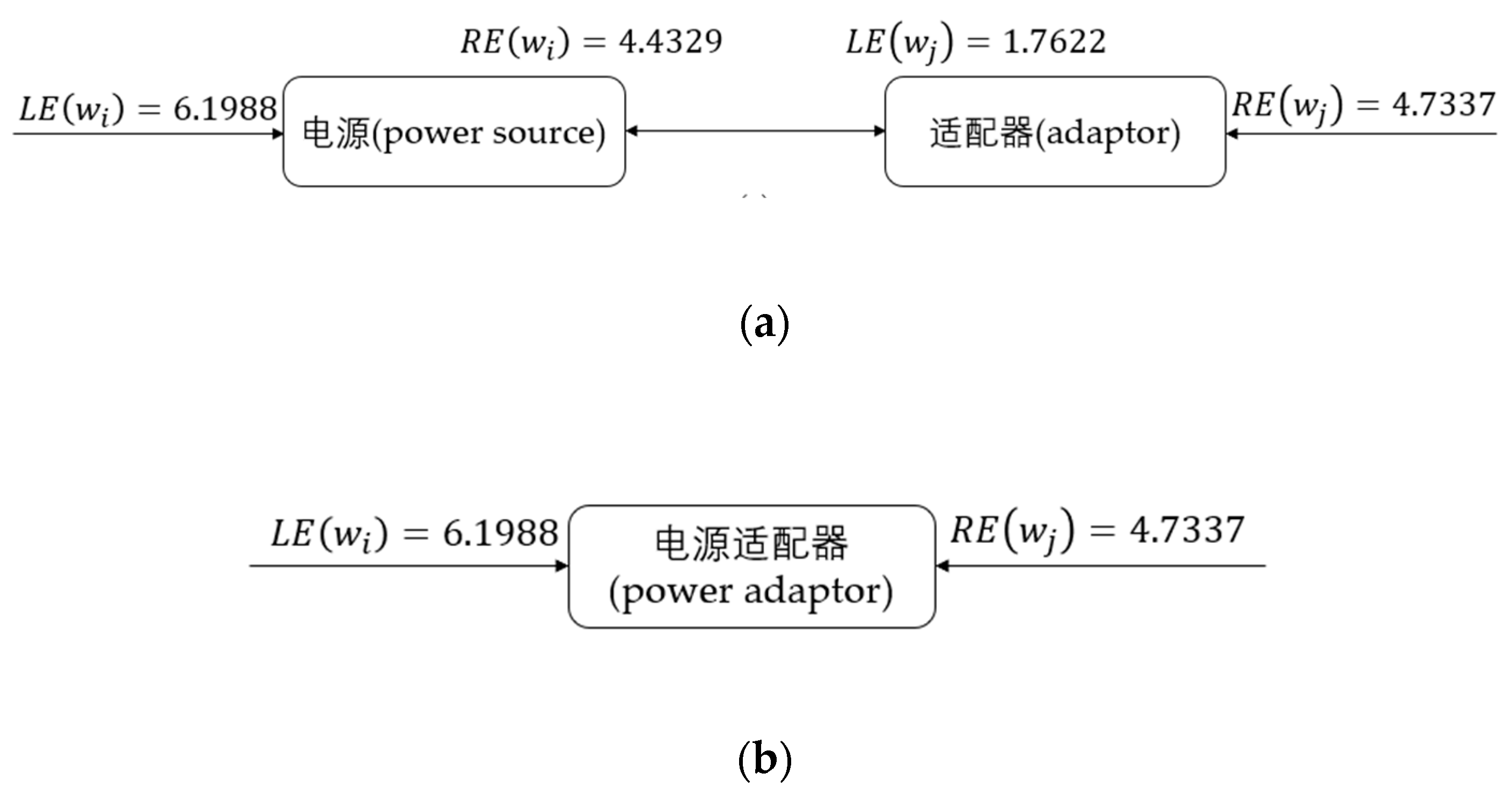
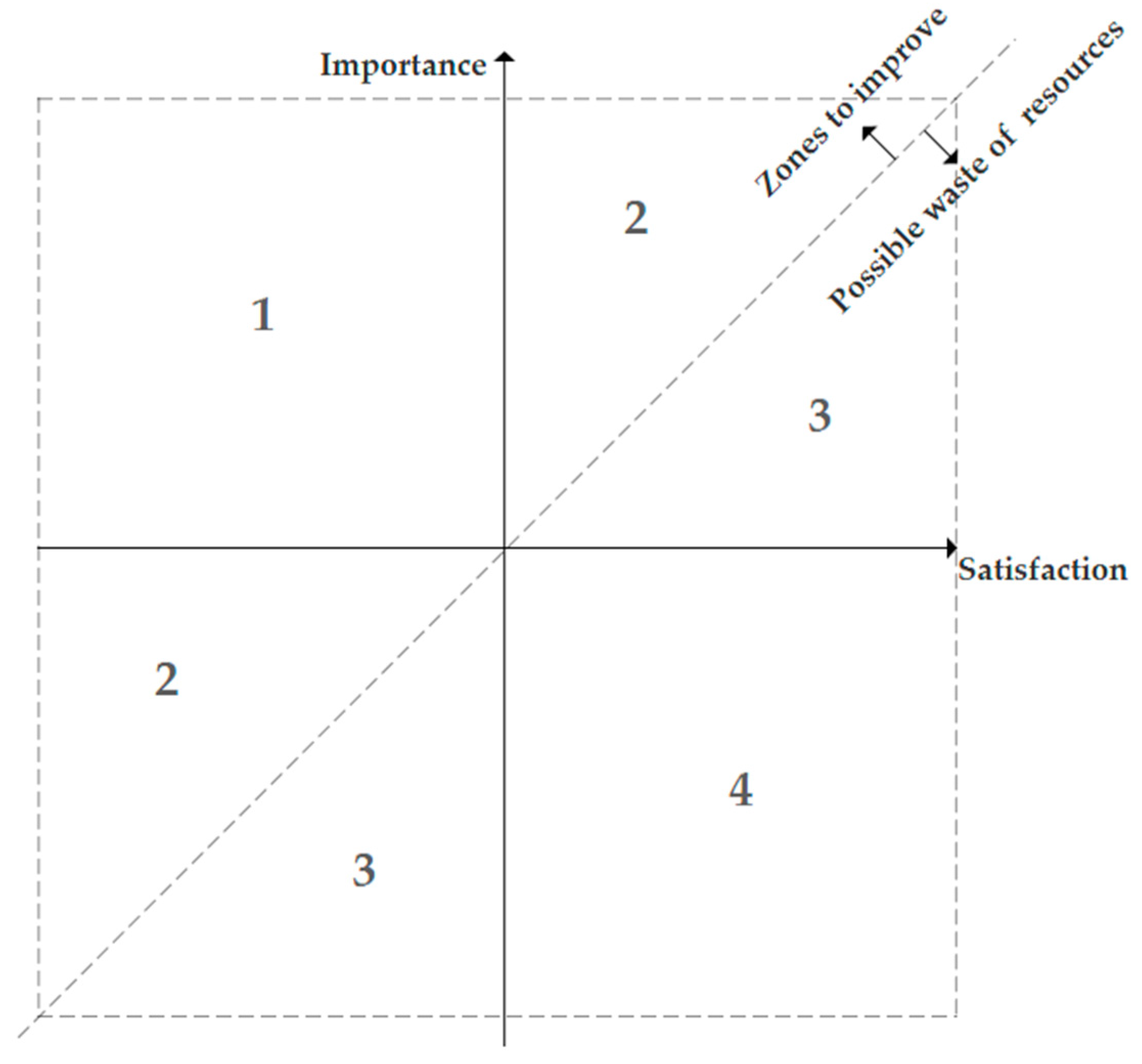
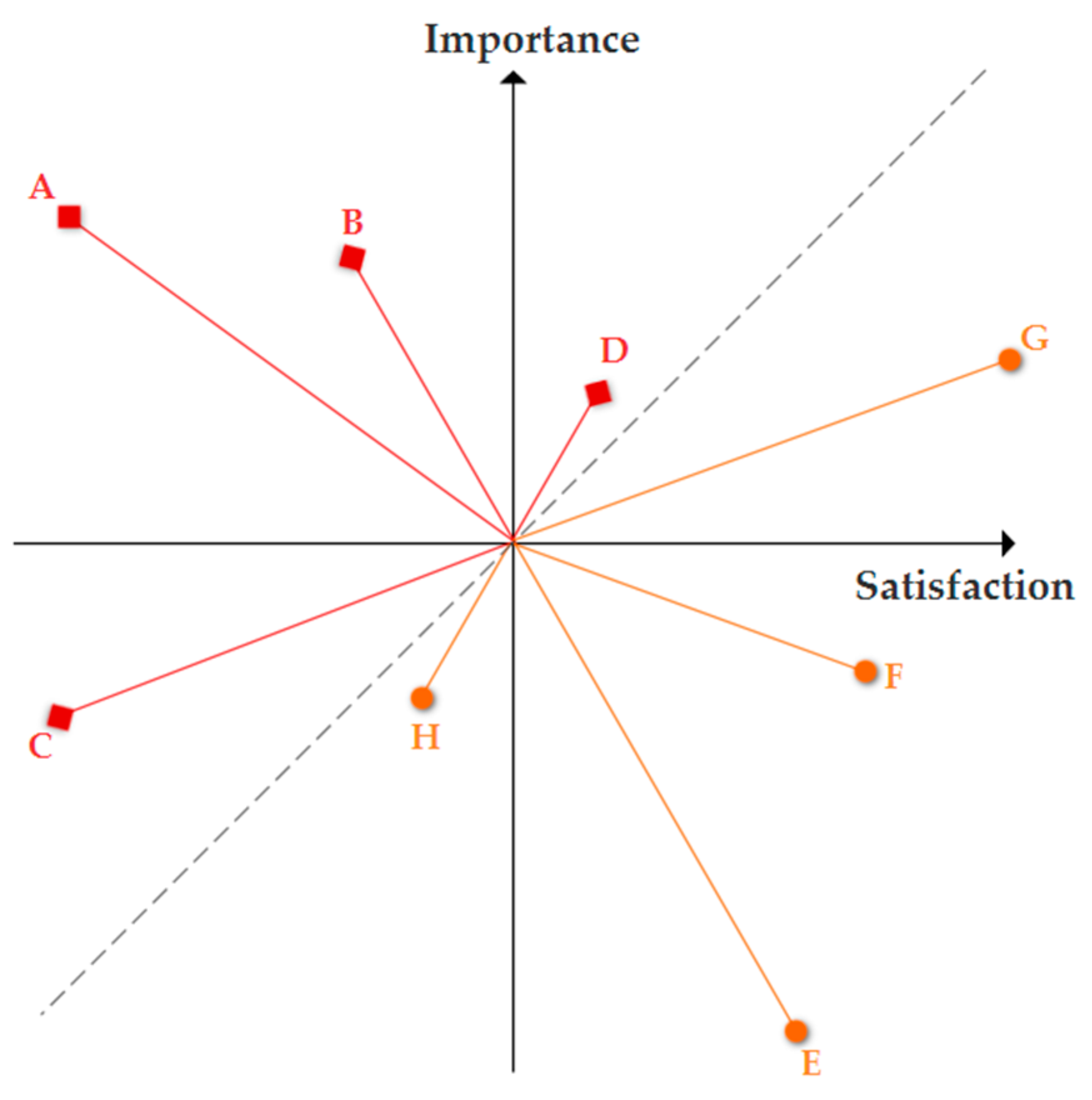
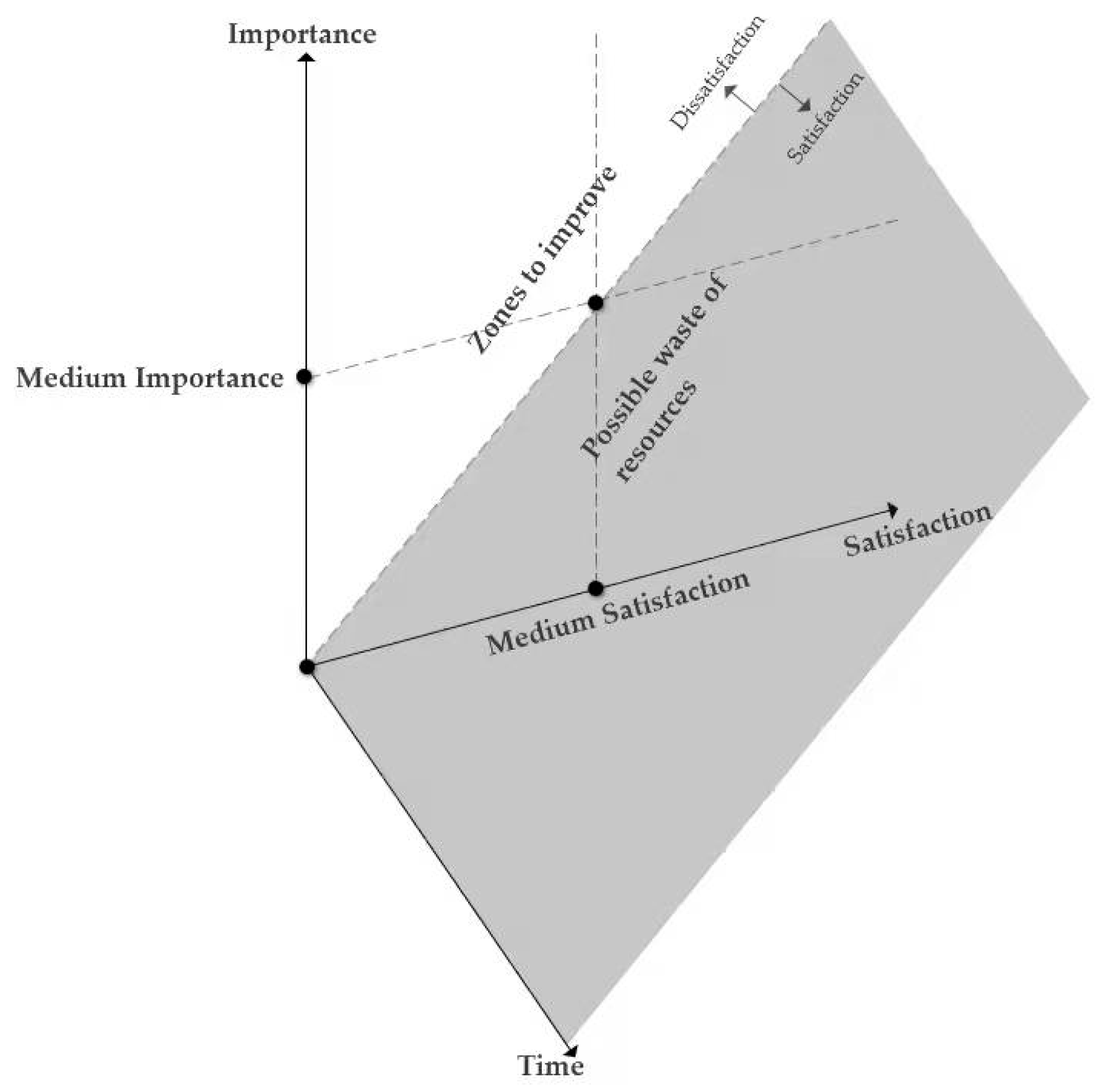
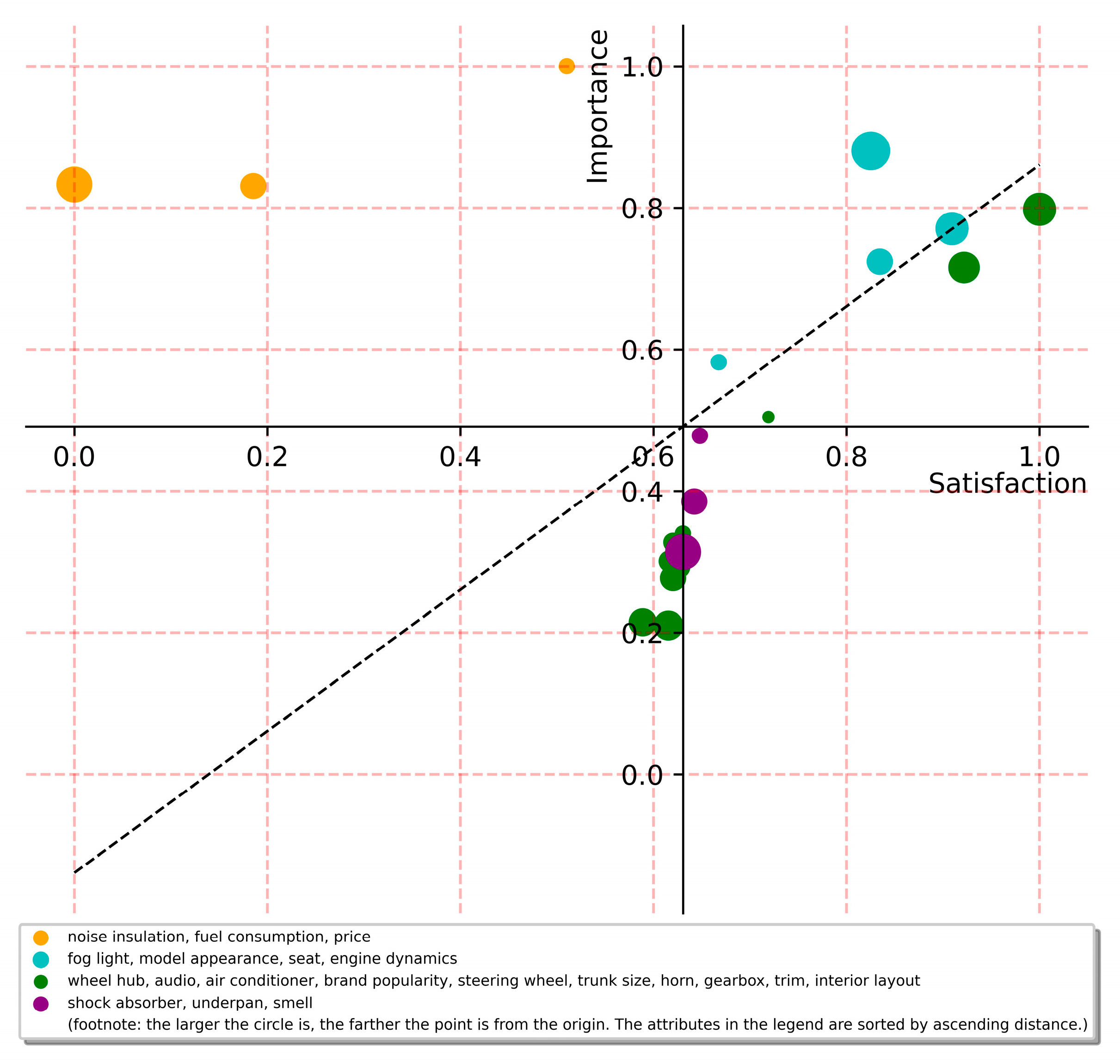

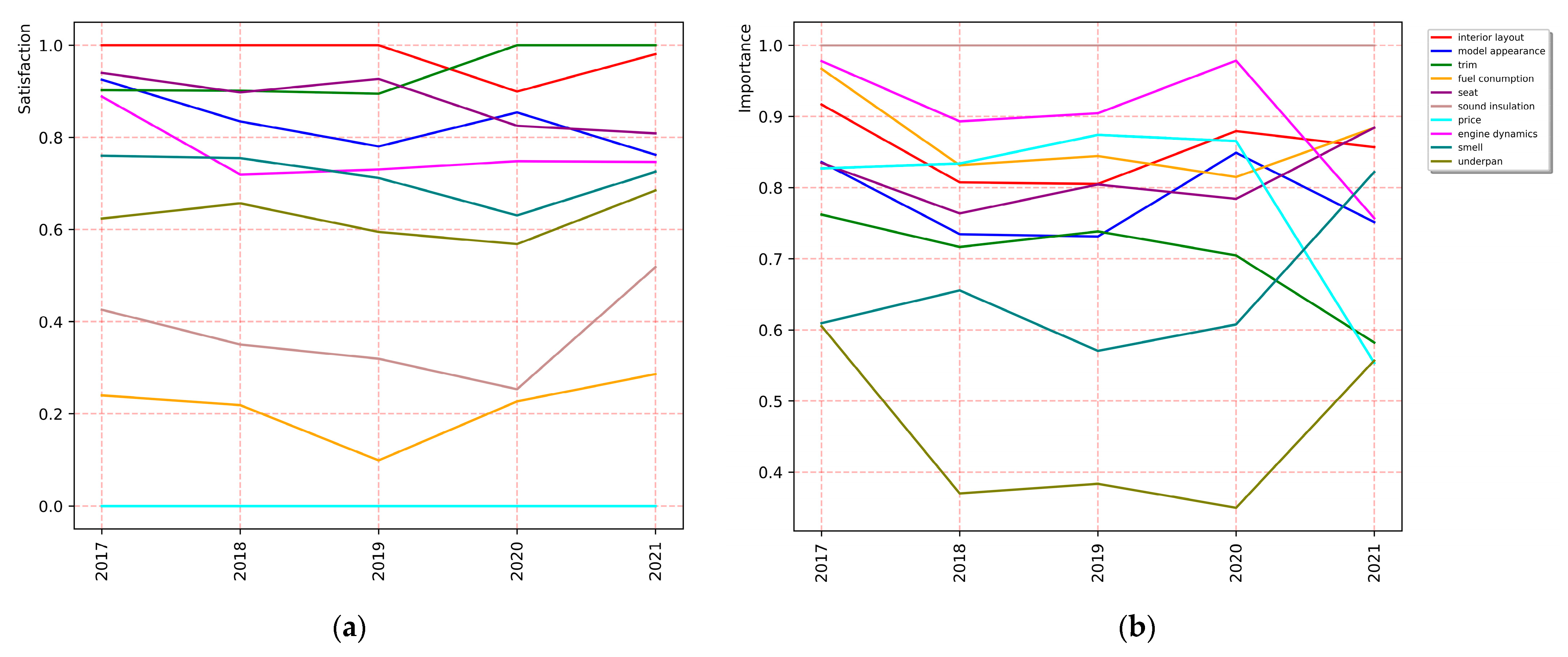

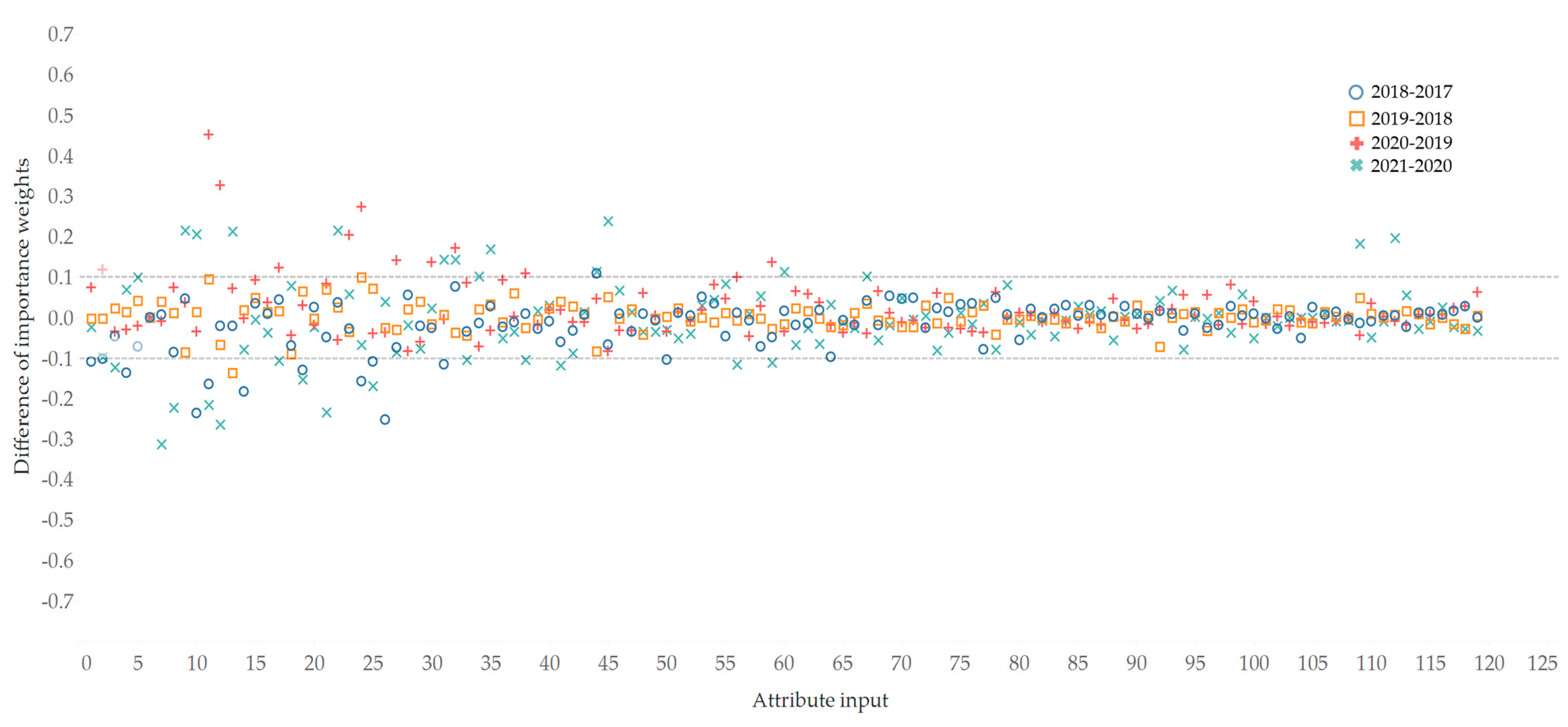
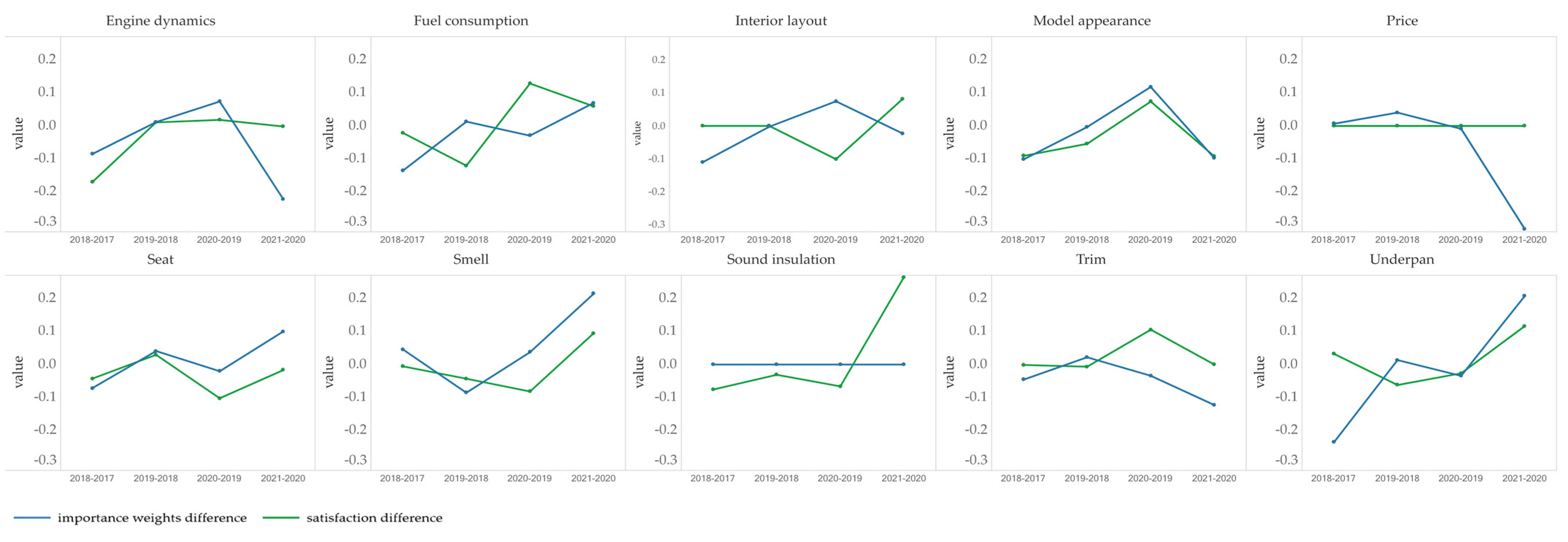
| Type of Text | Formula | Example | |
|---|---|---|---|
| Q1 | No feature word | “我很满意 (I like it very much.)” | |
| Q2 | Feature word + positive sentiment word | “座椅舒服 (The seat is comfortable.)” | |
| Feature word + negative sentiment word | “窗户脏 (The windows are dirty.)” | ||
| Feature word + privative words + positive sentiment word | “不喜欢后备箱 (I don’t like the trunk.)” | ||
| Feature word + privative words + negative sentiment word | “价格不贵 (The price is not expensive.)” | ||
| Q3 | Feature word + degree adverbs + positive sentiment word | “外观很大气 (The appearance is very gorgeous.)” | |
| Feature word + degree adverbs + negative sentiment word | “隔音棉很差 (The sound insulation cotton is really poor.)” | ||
| Feature word + privative words + degree adverbs + positive sentiment word | “我特别喜欢这个颜色 (I love the color very much.)” | ||
| Feature word + privative words + degree adverbs + negative sentiment word | “我老婆非常讨厌轮胎 (My wife really hates the tires.)” | ||
| Score | Examples | |
|---|---|---|
| Score of degree adverbs level | 3.0 | 极度 (extremely), 超 (super) |
| 2.0 | 非常 (very), 十分 (really) | |
| 1.5 | 比较 (relatively), 颇 (relatively) | |
| 0.5 | 有点 (slightly), 稍许 (somewhat) |
| Review | … | … | … | … | ||||||
|---|---|---|---|---|---|---|---|---|---|---|
| 1.5 | … | 0 | … | 2.0 | 0 | … | 1.0 | … | 1.5 | |
| 2 | 2.0 | … | 1.0 | … | 0 | 1.0 | … | 1.5 | … | 0 |
| … | … | … | … | … | … | … | … | … | … | … |
| m | 0 | … | 1.5 | … | 1.0 | 0 | … | 2.0 | … | 1.0 |
| Precision | Recall | ||
|---|---|---|---|
| Jieba | 70.83% | 68.77% | 69.79% |
| THULAC | 65.98% | 62.40% | 64.13% |
| BAE | 72.54% | 69.69% | 71.08% |
Disclaimer/Publisher’s Note: The statements, opinions and data contained in all publications are solely those of the individual author(s) and contributor(s) and not of MDPI and/or the editor(s). MDPI and/or the editor(s) disclaim responsibility for any injury to people or property resulting from any ideas, methods, instructions or products referred to in the content. |
© 2023 by the authors. Licensee MDPI, Basel, Switzerland. This article is an open access article distributed under the terms and conditions of the Creative Commons Attribution (CC BY) license (https://creativecommons.org/licenses/by/4.0/).
Share and Cite
Luo, H.; Song, W.; Zhou, W.; Lin, X.; Yu, S. An Analysis Framework to Reveal Automobile Users’ Preferences from Online User-Generated Content. Sustainability 2023, 15, 13336. https://doi.org/10.3390/su151813336
Luo H, Song W, Zhou W, Lin X, Yu S. An Analysis Framework to Reveal Automobile Users’ Preferences from Online User-Generated Content. Sustainability. 2023; 15(18):13336. https://doi.org/10.3390/su151813336
Chicago/Turabian StyleLuo, Hanyang, Wugang Song, Wanhua Zhou, Xudong Lin, and Sumin Yu. 2023. "An Analysis Framework to Reveal Automobile Users’ Preferences from Online User-Generated Content" Sustainability 15, no. 18: 13336. https://doi.org/10.3390/su151813336
APA StyleLuo, H., Song, W., Zhou, W., Lin, X., & Yu, S. (2023). An Analysis Framework to Reveal Automobile Users’ Preferences from Online User-Generated Content. Sustainability, 15(18), 13336. https://doi.org/10.3390/su151813336






